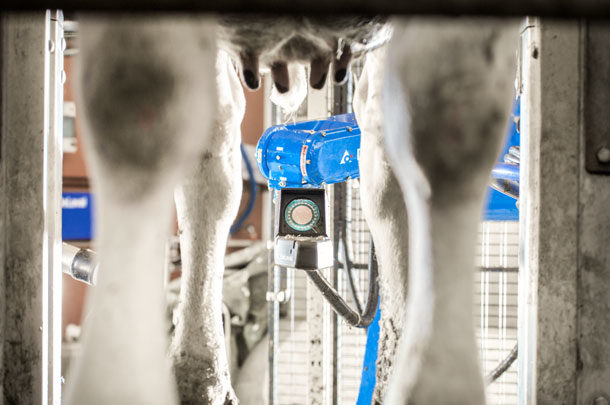The great football coach Vince Lombardi famously said, “Perfection is not attainable, but if we chase perfection we can catch excellence.” We carry this through to the dairy farm of tomorrow by focusing on the farm’s greatest asset: the cow.
We must also carry this through in a broader, global context to help support a sustainable dairy industry. In a world with a growing population and limited natural resources, we have to continue to produce more food with less impact on the environment. Producer profitability, animal welfare, care of the environment and social responsibility are four areas we must address in this ongoing pursuit.
An increase in cow longevity will be instrumental in helping us achieve this goal, as it touches on all four areas. Additionally, when we extend this goal to the technology solutions we produce, we further its impact by helping improve a producer’s efficiencies.
Improving efficiencies
Over the past decade, there has been a heavy focus on the automation of the milking process. A milking robot has proven to be an economic, sustainable and productive solution for small- and medium-sized farms.
Challenges related to the cost and management of labor, an increase in cow comfort and the goal of a better lifestyle have been the traditional drivers for robotic milking. For the same reasons, we see robotic milking gaining in popularity in the large dairy segment as well.
Automation in conventional milking systems, especially in the rotary parlor, is another trend we are witnessing. The rotary has become a primary choice for larger dairy operations based on its throughput and efficiency for both the cow and operator. This system has the added benefit of upgrades, which include the automation of certain processes (i.e., robotic spray application of pre- and post-dip), providing further opportunities for efficiency increases.
Automation in other areas of the dairy operation will progress rapidly over the coming years. Take, for example, feeding. Feed is the largest share of a farm’s operating costs, making up 50 to 75 percent of daily expenditures. Mixing, distributing and pushing feed throughout the day is one of the least desirable tasks a producer faces.
Today, automated systems can carry out these tasks and ensure fresh feed, optimized rations, reduced waste, potential labor savings and better feed efficiency. It also keeps rations within reach at almost any time of the day, enabling lower-ranked cows to improve their feed intake. This has the added benefit of helping increase the herd’s overall milk production.
Data integration will be another key to boost efficiencies and is a characteristic of tomorrow’s dairy operations. Technology enables the collection of information during the milking and feeding process and in the barn environment overall. A cow’s individual milk analysis, automated body condition scoring, heat detection and a continuous analysis of feed quality provide early indications about herd health, fertility and productivity. Integration and analysis of the data helps facilitate early decision-making before problems advance.
Improving longevity
Increasing numbers of dairy producers, whether managing large or small operations, name cow comfort as a key decision factor for automated milking solutions. Increasing the productive life cycle of a cow may financially outweigh the expenditures needed when a dairy experiences high turnover rates.
Though some turnover is expected, it is estimated that as many as 70 to 80 percent of all cullings are involuntary. The three reasons most often cited are lameness, mastitis and reproduction problems. A good, clean and stress-free barn environment, as well as increased attention to the individual cow based on better and more accurate information, will enable significant improvements in those areas.
The field of data integration, through the implementation of software, naturally lends itself to better farm and cow management. By simplifying interactions with the herd, producers can obtain useful knowledge and early warning signals.
This analytical information will provide input in areas such as animal health, milk production and milk quality. The data shows initial detection of diseases to allow early treatment and minimize downtime and health care costs. Pregnancy rates will continue to improve based on the usage of more accurate indicators such as progesterone.
Availability of data and remote system access provides the possibility of new farm services and will certainly impact the interaction and cooperation of the dairy producer with the veterinarian, nutritionist, milk processor or service technician.
Using this data increases the focus put on individual cows to optimize the balance between input and output. Individual cow management in small and large herds will continue to grab headlines as we find new ways to measure, analyze and provide data to the dairy producer and other stakeholders.
Catching excellence
The above-mentioned trends support the aspect of cow longevity as well as increased efficiency. They naturally complement a focus of producer profitability, animal welfare, care of the environment and social responsibility. Though we may speak about the future of dairy farming, many solutions are currently available. These solutions, however, are mere tools as the industry’s strength continues to lie with good managers and producers.
Our industry has seen significant increases in efficiencies and output over the past decades. It will continue to do so and, as in the past, developments in technology and dairy management will be key drivers in our pursuit of excellence. PD
PHOTO: The robot spray application of teat dip is just one example of how automation makes many tasks on the dairy more consistent and efficient. Photo provided by DeLaval.

-
Christian Poggensee
- Regional President - North America
- DeLaval Inc.
- Email Christian Poggensee





